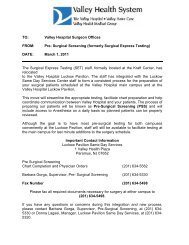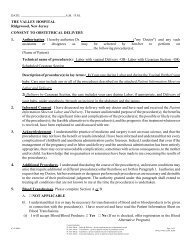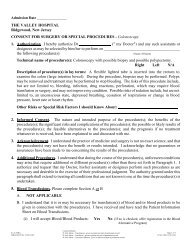Thyroid FNA Ultrasound Consent - Valley Hospital
Thyroid FNA Ultrasound Consent - Valley Hospital
Thyroid FNA Ultrasound Consent - Valley Hospital
You also want an ePaper? Increase the reach of your titles
YUMPU automatically turns print PDFs into web optimized ePapers that Google loves.
Admission Date ________________THE VALLEY HOSPITALRidgewood, New JerseyCONSENT FOR SURGERY OR SPECIAL PROCEDURES1. Authorization. I hereby authorize Dr. ("my Doctor") and anysuch assistants or designees as may be selected by him/her to perform on______________________________________ the following procedure(s):(Name of Patient)Technical name of procedure(s):Description of procedure(s) in lay terms:Right Left N/A________________________________________________________________________2. Informed <strong>Consent</strong>. The nature and intended purpose of the procedure(s); the benefits of theprocedure(s); the significant risks and complications of the procedure(s); the possible or likely results ofthe procedure(s); the feasible alternatives to the procedure(s); and the prognosis if no treatmentwhatsoever is received, have been explained to and discussed with me.3. Acknowledgement. I understand the practice of medicine and surgery is not an exact science, and thatthe procedure(s) may not have the benefit or results intended. I acknowledge that no guarantees orassurances have been made to me concerning the results of the procedure(s).4. Additional Procedures. I understand that during the course of the procedure(s), unforeseen conditionsmay arise that require additional or different procedure(s) other than those set forth in Paragraph 1. Iauthorize and request that my Doctor, his/her assistants or designees perform such procedures as arenecessary and desirable in the exercise of their professional judgment. The authority granted under thisparagraph shall extend to treating all conditions that are not known to me at the time the procedure(s) isundertaken.5. Blood Transfusions. Please complete Section A or BA. NOT APPLICABLEB. I understand that it is or may be necessary for transfusion(s) of blood and/or blood products to begiven in connection with the procedure(s). I have received and have read the Patient InformationSheet on Blood Transfusions.(i) I will accept Blood/Blood Products: Yes No (If no is checked, offer registration in the BloodAlternative Program)(ii) In connection with my consent to transfusion(s) of blood, my Doctor has provided me withinformation about, and has discussed and explained the following:IC-2 MRec <strong>Consent</strong> Includes:Page 1 of 5MB-06/83;07/96; 12/98, 01/02 Pt. Info. Sheet – Transfusions - given to patient not part of permanent recordPt. Info. Sheet – Anesthesia - given to patient not part of permanent recordPt. Info. Sheet – Conscious Sedation - given to patient not part of permanent record12/98, 2/00, 01/ 02, 4/03
THE VALLEY HOSPITALRidgewood, New JerseyPATIENT INFORMATION SHEETBLOOD TRANSFUSIONSDuring the course of your medical treatment it may become necessary for you to have a transfusion ofblood or a transfusion of a component of blood. Transfusions can be homologous (blood that comes fromthe community blood bank), directed (donations from relatives or friends) or autologous (donations thatcome directly from you).Autologous (self-donated) blood has the least risk of all. Directed donations are not recognized as beingany safer than ordinary bank blood donations.Autologous blood must be donated in advance of elective surgery. Directed donations also requireadvance notice. These options should be discussed with your Doctor.All community blood bank products are obtained from volunteer sources who do not receive any paymentfor their blood. Before giving blood, each donor is screened. If relevant health problems are discovered,the donor is not accepted. The blood from each donor undergoes testing, including tests for AIDS (HIV),hepatitis, and syphilis. The medical community feels that our modern knowledge and technology havemade transfusions safer today than they have ever been in the past.There are risks from transfusions, but risks of serious or fatal complications are very rare. For instance,the risk of acquiring the AIDS virus through a transfusion is much less than it was several years agobecause of the available screening tests. The incidence of acquiring AIDS today through a transfusion hasbeen estimated at 1:2,000,000 1 which is probably much less than one's chances of being a fatality in amotor vehicle accident. Other risks include hepatitis, fever, hemolysis (a breakdown of red blood cellsdue to an immune reaction which may cause anemia and kidney injury), and heart failure due to anexcessive amount of fluids.Transfusion risks must be weighed against benefits, and criteria have been established to aid your Doctorin making a decision about whether or not to transfuse.In summary, the safest transfusion is autologous (self-donated), but autologous transfusions require theluxury of advance notice, and are usually suited only to elective surgery. While directed and communitytransfusions have more risk, the medical community is trying to make them safer than they have ever beenbefore. Your Doctor must make the decision to transfuse or not, based on medical science and judgment.If you or your Doctor decide to utilize autologous and/or directed blood, please call the BergenCommunity Blood Center for further information at (201) 444-3900.IC-2 MRec Page 3 of 507/96,03/01,01/02,01/061 Reference: AABB Technical Manual, 15th Edition, 2005.
THE VALLEY HOSPITALRidgewood, New JerseyPATIENT INFORMATION SHEETON ANESTHESIAThe purpose of surgical anesthesia is to relieve pain during surgery through the use of various medications ordrugs known as anesthetic agents. Along with the delivery of the anesthetic agent, life support measures areoften undertaken in order to maintain the well-being of the patient. These measures might include theadministration of blood or blood products (unless such blood or blood products have been refused); use ofmedications and equipment to support the heart, lungs or other systems of the body; antibiotics (drugs used toprevent or treat infection); and medications to counteract disease states or correct imbalances.Surgical anesthesia may be general, regional or local with intravenous conscious sedation. The type ofanesthesia selected in a given case will depend on the medical condition of the patient, the nature of theprocedure to be performed, and the preferences of the patient and of the surgeon.General anesthesia is a method of surgical anesthesia in which the patient is rendered unconscious andinsensitive to pain (will be asleep) through the use of anesthetic agents administered by inhalation (breathingan anesthetic gas through a mask) and/or by intravenous injection (using a small tube (catheter) to place theanesthetic agent into a vein and, thus, into the patient's bloodstream). The anesthetic agent, the route ofadministration, the dosage, and the depth of general anesthesia are dependent on the nature of the surgery to beperformed, the medical condition of the patient, and other considerations. Endotracheal intubation, in which abreathing tube is placed into the windpipe, is often necessary. Occasionally, patients complain of a sore throat,nausea and/or vomiting after undergoing general anesthesia. Strokes, brain damage and heart attack are rarecomplications of general anesthesia.Regional anesthesia is a method of surgical anesthesia in which anesthetic agents are used to numb a group ofsensory nerve fibers in order to make an area of the body insensitive to pain. Sometimes a tourniquet is usedon an arm or leg and an anesthetic agent is injected into a vein of that arm or leg. During this type ofanesthesia a sedative to relax and calm the patient during the surgery is used. Occasionally, for technicalreasons, it is not possible to produce this type of anesthesia or it is not completely satisfactory. When thisoccurs another type of anesthesia, usually a general anesthetic, is added. Two of the commonly used types ofregional anesthesia are epidural and spinal anesthesia.Local anesthesia with intravenous sedation is where a local anesthetic agent is injected into the site to beoperated on by the surgeon to block sensory nerves. This makes that area of the body insensitive to pain ornumb. During this type of anesthesia, a sedative to relax and calm the patient is often given intravenously.In epidural anesthesia an anesthetic agent is injected into the epidural space to anesthetize (numb) the legs,pelvis, abdomen, or other area of the body. With this type of anesthesia a small tube (catheter) is inserted intothe epidural space so that additional anesthetic agent can be injected as needed. Rare complications ofepidural anesthesia include infection and paralysis.In spinal anesthesia the lower part of the body is made insensitive to pain by injecting an anesthetic agent intothe fluid which bathes the spinal cord. Infrequently, a post-spinal headache may occur. Rare complications ofspinal anesthesia include infection and paralysis.On the day of surgery, your anesthesiologist will speak with you to answer any questions you may have. If you wish tospeak with an anesthesiologist prior to this, please call the Anesthesiology Department at (201) 447-8700.IC-2 MRec Page 4 of 507/96,10/98, 01/02
THE VALLEY HOSPITALRidgewood, New JerseyPATIENT INFORMATION SHEET ONCONSCIOUS SEDATIONThis patient information sheet has been developed to explain conscious sedation.Conscious sedation is a controlled state of extreme relaxation often resulting in little memory of the procedure.This type of sedation reduces pain and awareness of the procedure while allowing the patient to breathe onhis/her own and to respond to verbal commands and/or gentle stimulation. Many times a patient will not evenrecall having spoken to the staff during the procedure. Conscious sedation allows a patient to tolerate theprocedure by relieving anxiety, discomfort and/or pain. For procedures that require children not to moveconscious sedation will help them to remain still.Informed consent must be obtained before the procedure and before the patient receives conscious sedation.In children, the informed consent must be obtained from a parent or guardian of the child before conscioussedation is administered. A physician or a nurse may administer conscious sedation. The patient is monitoredbefore, during and after the procedure.If the patient is going home, arrangements should be made for a responsible adult to take the patient home.There are some risks with conscious sedation. The risk is dependent upon many factors including the type ofprocedure and the medical condition of the patient. Fortunately, adverse events are rare.IC-2 Mrec Page 5 of 5MB-4/99 01/02
















